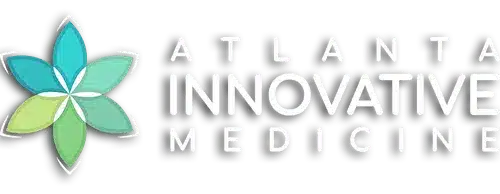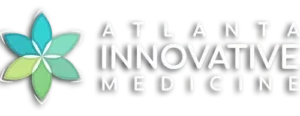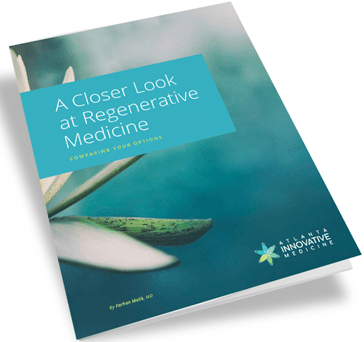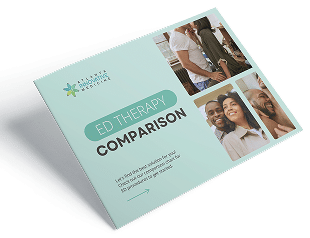By Farhan Malik, MD
Atlanta Innovative Medicine
If you are one of the millions of adults living with symptomatic arthritis, spine pain, or other persistent joint pain, medication is not your only option for relief.
Joint and spine pain can be caused by many factors, including poor posture, lack of movement, aging, injury, or medical conditions such as degenerative disc disease, osteoarthritis, or sciatica.
Oftentimes, nonsteroidal anti-inflammatory drugs (NSAIDs), like aspirin and ibuprofen, are the first prescribed method of treatment. But these drugs can lead to painful or disruptive side effects such as indigestion and headaches. When NSAIDs are used for extended periods of time, they can even have dangerous implications like heightened blood pressure and increased risk of heart attack.
Sometimes, opioids and steroids are prescribed instead of NSAIDs to manage pain and inflammation. However, these drugs also carry a risk of negative side effects.
Fortunately, there are several alternative remedies to consider that can effectively and safely alleviate pain and stiffness for ongoing relief and increased mobility.
1. Balanced Movement — Sitting in the same position for extended periods of time puts excess pressure on the lower back and hips. If you are someone who sits for work or whose lifestyle otherwise involves long, stationary periods, alternating your body’s position and taking breaks for movement is vital for maintaining good posture and reducing muscle tension.
Alternating between sitting and standing, even if remaining stationary, can make a big difference. Incorporating movement into your daily routine, such as taking the stairs instead of the elevator; walking, biking, or parking further away from your destination; or taking frequent, short breaks to walk or stretch, can help maintain balance and prevent muscle strain.
2. Good Posture — Poor posture is a leading cause of joint and spine pain. Hunching forward, slouching, or carrying something heavy on one side of the body can place imbalanced strain on certain muscles, put pressure on spinal nerves, and cause misalignment in the joints.
It’s easy to get in the habit of poor posture without even realizing it, so a good place to start is simply becoming aware of your body alignment throughout the day. Keep your shoulders back and relaxed, chin parallel to the ground, and hips aligned with your feet. When sitting, ensure that your back is supported by the chair and your feet resting flat on the floor. A lumbar cushion can provide extra support by supporting the natural curve of the lower back.
If your work requires you to be at a desk all day, you might also consider replacing your chair with an exercise ball, or trying out a standing desk.

3. A Supportive Mattress — A mattress that is too soft or old can cause your body to sink, which can put stress on your muscles and joints; and a mattress that is too firm may not offer enough pressure relief.
The ideal mattress depends on your specific body type, sleeping position, and type of pain; but generally you want your mattress to be firm enough to support your body weight while still allowing your spine to maintain its natural curve. Though it may last longer, a high-quality mattress doesn’t last forever: it is recommended that you replace your mattress every 7–10 years, depending on its condition.
4. Proper Footwear —Unsupportive, oversized, or undersized shoes can cause problems far beyond the feet, exacerbating pain in the joints, muscles, and nerves throughout the body. Additionally, improper sports footwear can increase the risk of twisting or fall-related injuries.
For daily wear, choose shoes that have sufficient cushion, support, and a fit that leaves enough room for your toes to move. When exercising, choose activity-specific footwear that offers the right level of give in the heel and enough ankle support for walking, hiking, or running. Additionally, orthotics, or shoe inserts, can provide support by redistributing weight and alleviating pressure.
5. Core Muscle Strengthening — The muscles in your core support your spine, pelvis, and abdomen, so maintaining their strength helps prevent strain on the lower back, as well as prevent future injuries.
Pilates, water aerobics, and yoga offer a great way to maintain and build these muscles’ strength through exercises that focus on proper form and alignment. If you’re new to any of these activities, start with simple movements, progressing to more advanced exercises as you build strength and increase flexibility. And you do not have to join a gym or otherwise pay for yoga or Pilates–just grab a mat and go choose from hundreds of videos on YouTube!
6. Stretching and Warming Up — To prevent injury or exacerbated symptoms during exercise, it’s important to warm up and cool down every time.
Warming up should include exercises that activate large muscle groups and dynamic stretches that improve range of motion and flexibility. Cooling down should include static stretches, like cobra pose and seated butterfly stretch, to loosen the muscles and prevent soreness.

7. Braces and Wraps — For some conditions and injuries, supportive braces and compression wraps can improve circulation and reduce inflammation, alleviating exercise-induced pain.
Knee braces, for example, can help stabilize the knee joint and reduce pressure on the knee cap. Talk to your doctor or physical therapist to determine if braces or wraps are appropriate for your condition and if so, what type of brace or wrap is best for you.
8. Diet — Many types of joint pain are caused or exacerbated by inflammation, and inflammation is directly affected by our diet. So, by choosing anti-inflammatory foods and limiting consumption of foods that cause inflammation, you can provide your body with significant relief.
Cold-water fish, chia seeds, walnuts, and other foods containing omega-3 fatty acids have anti-inflammatory properties. In contrast, processed foods, trans-fats, and added sugars can heighten inflammation. Additionally, antioxidant-rich foods, like fresh fruits and vegetables, can help prevent deterioration and the related risk of damage or injury.
9. Sleep — Sleep disturbances and insufficient sleep trigger pro-inflammatory cycles that sustain inflammation and cause pain throughout the day.
If you have difficulty falling or staying asleep, it’s important to take extra steps to support your body’s sleep, such as:
- Sticking to a routine, aiming to go to sleep at approximately the same time each night
- Ensuring a cool and comfortable sleeping environment
- Limiting noise interruptions or racing thoughts by listening to white noise, relaxing music, or a sleep story
- Creating time to meditate or otherwise unwind to reduce stress before sleep
- Taking a natural sleep supplement, like vitamins C, vitamin B6, melatonin, L-theanine, or valerian.
10. Stress Management — It’s not just a barrier to good sleep—stress itself can lead to inflammation and heightened joint pain. So incorporating stress-relieving activities into your routine can make a big difference.
A 5–15 minute mindfulness practice every morning can do a lot to reduce daily stressors. Some other simple relaxation practices include:
- Deep breathing exercises
- Guided meditation classes (Many can be found online through platforms like Calm or Insight Timer.)
- Gentle yoga
- Therapy for people with anxiety or other emotional disorders
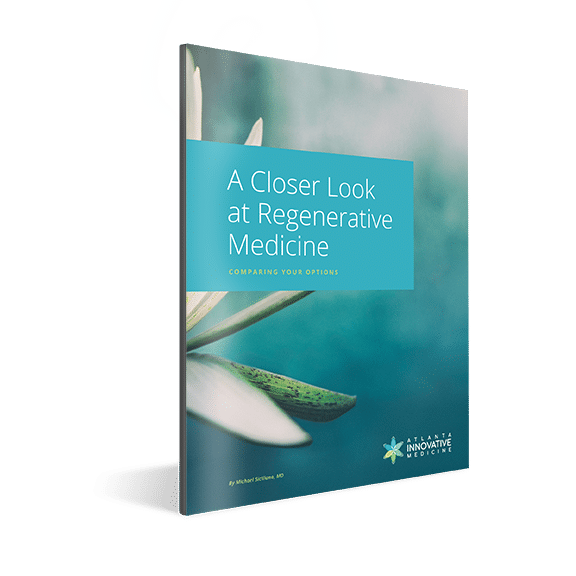
Subscribe for Expert Insights and Our Ebook
A Closer Look at Regenerative Medicine: Comparing Your Options Learn about treatment options like Platelet Rich Plasma (PRP), Prolozone Therapy, and Stem Cell Therapy.
11. Heat and Cold Therapies — By applying heat or cold to the pain points along your spine or in your joints, you can quickly reduce inflammation and release muscle tension.
Heat application, using a hot gel pad, hot water bottle, or electric heating pad, can increase blood flow and relax muscles. Applying cold packs can reduce inflammation and provide immediate relief by numbing the pain.
12. Epsom Salts and Essential Oils — Warm water and epsom salt baths can also be helpful for reducing pain and inflammation. Adding essential oils to the bath, such as lavender or peppermint, can enhance the soothing effect.
Epsom salts contain magnesium, which is a natural muscle relaxant which magnifies the effects of a warm bath. Aroma therapy can further magnify these effects by promoting relaxation. In addition to mixing them into your bath, try carrying a bottle of soothing essential oil with you and regularly applying it to your wrists or chest to promote relaxation.
13. Supplements and Vitamins — Anti-inflammatory herbs such as turmeric (which contains curcumin) and ginger, can be taken in supplement form for a high concentration that will provide stronger anti-inflammatory effects.
Some other supplements with anti-inflammatory or antioxidant properties include:
Essential fatty acids (EFAs)
Electrolytes
Glucosamine
Vitamin D
Calcium
Replenishing electrolytes can also ensure proper hydration and balanced fluid levels to prevent muscle spasms and joint pain.
Natural remedies can take you a long way in preventing injury and managing pain, but some situations call for additional support. Fortunately, this does not have to mean resorting to surgery. There are several nonsurgical therapies and treatments that can not only reduce pain but promote lasting healing too.
14. Physical Therapy & Chiropractic Care — Some such therapies are physical therapy and chiropractic care. Physical therapy involves exercises and stretches to improve flexibility, strength, and mobility, as well as guided adjustments in posture and body mechanics to prevent future injuries. Chiropractic care involves spinal manipulation and other techniques to realign the spine and improve joint function.
When used in conjunction, these two therapies can be particularly effective. At Atlanta Innovative Medicine, we take an integrative approach that maximizes the benefits of both of these methods by combining them into one tailored treatment for our patients.
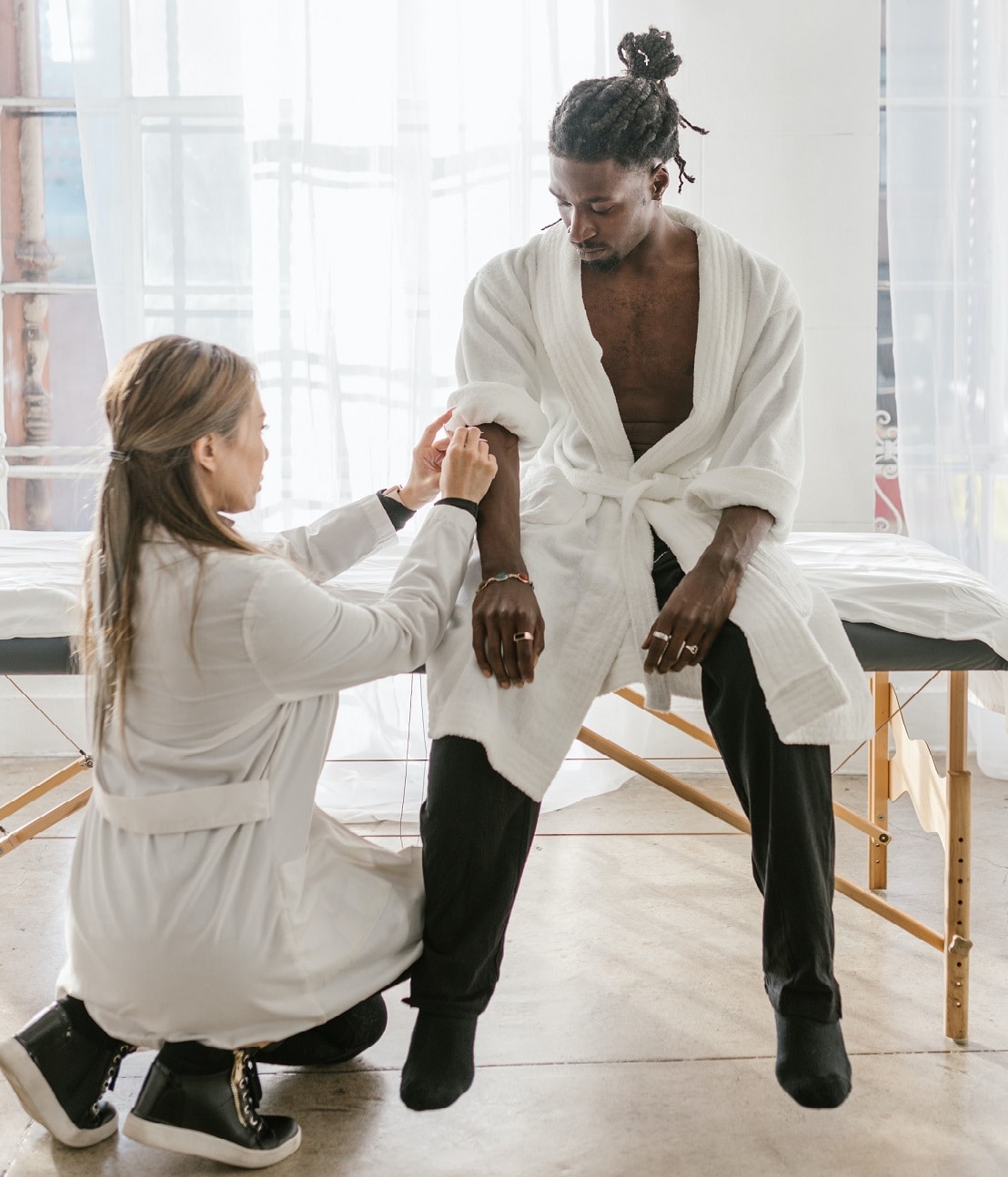
15. Regenerative Treatment — Growing advancements in regenerative medicine allow for many patients with both chronic joint pain and injury-related pain to achieve long-lasting healing through safe, noninvasive treatments. Some of these regenerative treatments, which have been highly researched and become widely utilized, include:
- PRP therapy, which leverages the growth factors found in one’s own blood by injecting a platelet-concentrated solution of plasma into the damaged area
- Prolozone therapy, which reactivates the body’s healing by restoring or redistributing the oxygen that is essential to the healing process
- Prolotherapy. which initiates healing by injecting a mild, natural irritant, like sugar, to engage the body’s immune response
- Stem cell therapy, which redirects the regenerative power of stem cells by injecting them into the damaged area
All of these therapies draw on the body’s own healing components, meaning there is no risk of rejection by the body and making them highly safe and typically quite successful.
In addition to physical therapy and chiropractic care, the doctors at Atlanta Innovative Medicine use one or a customized combination of these therapies to deliver patients with the quickest, most effective recovery possible through safe, noninvasive treatments.
You don’t deserve to live in pain, and you don’t need to rely on unsustainable medications or invasive surgical procedures.
Learn how you can heal and treat joint pain by calling Atlanta Innovative Medicine to schedule a complimentary consultation today: 770-416-9995
Quizzes
Are you a candidate for Regenerative Medicine?
Regenerative medicine can be an effective therapy and treatment option for lasting pain relief for a variety of conditions like osteoarthritis of the knee, hip or shoulder; ACL or meniscus tears; tennis or golfer’s elbow; chronic neck and back pain; and more.
Is it right for you and your condition? Take 1 minute to answer a few “yes or no” questions that help to assess if you might be a candidate for PRP, stem cell or other nonsurgical regenerative treatments.
Are You a Stem Cell Candidate for Your Joint or Spine Damage?
Are you a candidate for Platelet Rich Plasma (PRP) Therapy?
Do I have nonsurgical options for my injured or aging joints?
Take the Pain Medications Risk Quiz
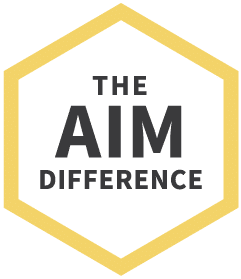
Regenerative Medicine.
Reimagined
- Advanced hybrid therapies, including Mesenchymal Stem Cell therapy combined with different mechanisms of action that synergistically come together to support ultimate healing
- More powerful PRP that’s customized, amplified and personalized
- Therapies delivered by an experienced, compassionate team comprised of multidisciplinary experts in traditional and alternative medicine working as your team: Medical Doctors, Nurse Practitioners, Physiotherapists and Chiropractors
- Advanced training through the American Academy of Orthopedic Medicine, the American Osteopathic Association of Prolotherapy Regenerative Medicine, and more
All content of this page is for informational purposes only and is not intended to serve as a substitute for the consultation, diagnosis, and/or medical treatment of a qualified physician or healthcare provider. Individual results may vary. Your medical professional can explain all the risks and potential benefits of any therapy based on your specific circumstances. At this time regenerative therapies are not FDA approved. Neither Atlanta Innovative Medicine nor its physician affiliates promise regenerative therapies as a cure for any condition, disease, or injury.
Other Atlanta Areas We Service:
© 2024 Atlanta Innovative Medicine, LLC. All Rights Reserved. AIM Scholarship Opportunity
